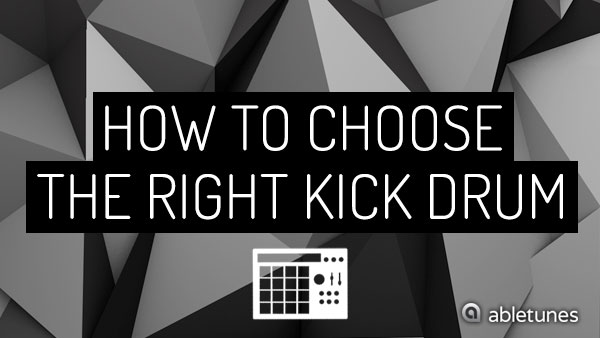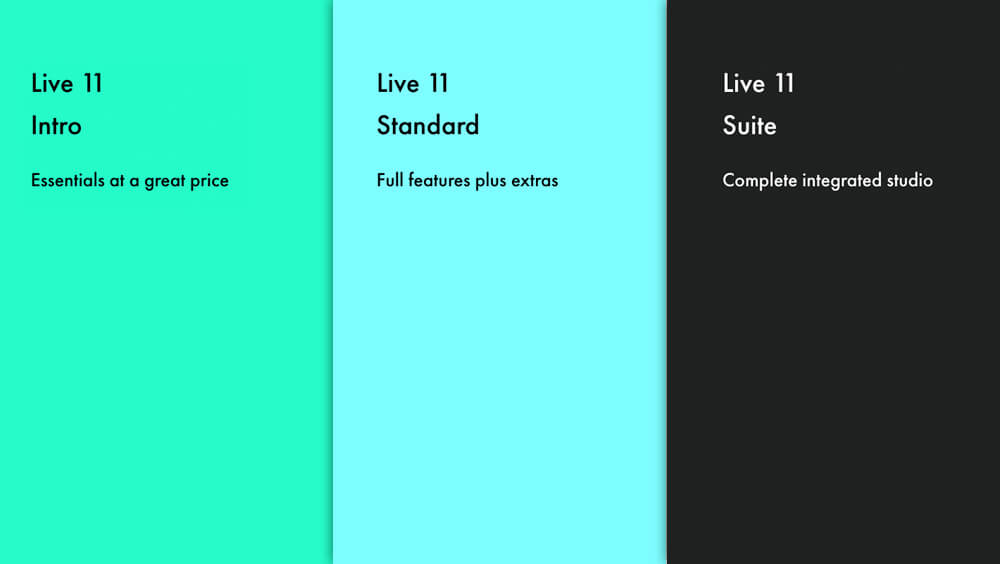How to Choose the Right Kick Drum

Ready to take over the electronic music scene but can’t seem to find the right kick? That’s ok! Abletunes has you covered! Back again with some crucial kick drum know how, we’re going to walk you through what it takes for you to find the right kick drum for your next EDM banger.
Finding and choosing the right kick drum does not have to be a difficult task, although it can make or break your song. We all know, when we hit up the clubs, no one ever says “OMG DUDE, Listen to that high hat!” because IT’S ALL ABOUT THE BASS! And, the bass is being driven by the kick! The kick is the power behind the track and creates the forward motion that moves the crowd. Choose the wrong kick drum and you could be holding your track back from its true potential. Here are our tips on choosing the right kick:
1. Match the Kick to the Style

Most genres have a certain feel to them. I think we can all agree, whether it be Hip Hop’s huge sub bottoms or Minimal’s Short and punchy kicks, all genres tend to (for the most part) have a certain style of kick that defines them. When most new producers are getting started, a common mistake is picking a kick drum that moves their track away from its intended sound destination. Here, we’ve listed most of the main genres and the style of kick that usually follows suit. This is just a rough guide. Every rule can be broken in some cases but this should give any producer a good starting point to get the ball rolling:
Trap – Use a long 808 kick.
Breaks / Drum & Bass – Depending on the bass line, you can really use either type of kick here.
Dubstep – Short and punchy to leave some space for bass.
EDM – From distorted Hardstyle kicks to “Swedish” with “click attack and linear tail”. Listen to your favorite tracks.
Techno – Traditionally 909 and 808 kicks, usually with soft attack. Rules can be broken here.
Deep/Tech House/Minimal – Depending on the bass line, you can really use either type of kick here. Sounds are very open to interpretation with these styles.
Psy Trance – Short tail. Tight and punchy. Not too much low end sub. More room for deep rolling bass line.
Trance – Not to sub heavy, but still enough bottom to move the low end on a good system. More tight upper mid range punch is preferred here.
2. Tail Length
No, we’re not talking about your awesome hair. Were talking about how long the kick drum sustains/releases. Tail length can make all the difference in allowing your bass line to breath. Have a tail length that is too long and it will certainly collide with your bass if you’re trying to lay down a deep groove. When using a kick with a long tail you’re going to want to try to keep your bass line punchy and use shorter note lengths that won’t interfere with your kick as well as keep the deep lows cut from the sound. The opposite can be said when using big deep sub bass lines. Here, you might want to keep your kick tail on the shorter side with more of a mid range punch.
3. To Mono or Not to Mono?

Keeping your kick and other lower frequency elements in mono is always a good idea. The main reason is that most relevant club systems are still wired in mono. Keeping these parts in mono will ensure they translate well on those big systems. Another good reason for keeping the lows in mono is that it allows you to use the full bandwidth of the stereo channel for maximum impact. If you do decide to go against the grain, you could try including some stereo information such as layering a stereo sound with the kick to create the click on top of the mono kick bottom. It’s also important to note that most sample packs come with mono kicks. Use your stereo analyzer to check your samples, especially when layering to make sure you are not having any issues with phasing which will cause you to loose punch.
4. You Get What You Pay For

When deciding on your kicks, make sure you are using quality audio samples. When you’re first getting started, there are many websites, Youtube channels, Soundcloud sets and blogs that offer up free samples normally for a “like” or to promote their work. Although some of them may be good, it’s best to front a couple of bucks to purchase a good sample pack for the quality kicks that you need. This is especially good advice to anyone who might be monitoring on a budget where it would be harder to properly control lower frequencies. If you’re curious as to what kicks or samples your favorite producers are using, look them up on Youtube and see if they’ve done any tutorial, production or interview videos. If you’re really keen to know, send them a message! Some producers are not too hard to reach and would be more than happy to help a fellow up and coming producer. Some producers such as Deadmau5 have even produced their own pack which you can get on most sample sale sites. Honorable mention here to: Sample Magic, Loopmasters, Vengeance, Zenhiser and CR2.
5. Make it Shiny!

We all know you can’t literally polish your kick physically, but you can apply some dynamic treatments that will help your kick stand out and cut through the mix. Some EQ, Compression, Reverb and Saturation are all just a few tools that you can use to help enhance your kick drums. Bear in mind, processing your kick is a very big topic and definitely warrants another article to explore in more depth. For now, just know that if you start with a low quality or bad kick drum sample (See #1, #4) that there isn’t enough EQ or compression on the planet that will help make it sound good. For best results, it’s best to just start with a good kick and avoid having a heavy hand when applying any dynamic processing. Hard Processing in the hands of a novice will generally never yield desirable results. You may want to make time to dial up some tutorials and explore more on this topic.
6. Tuning
More and more these days, we are seeing many sample labels releasing packs with the common theme of titling their product: “KICKS IN KEY”. While this is a great tool to have at your disposal, you can learn to tune any kicks you have now with a little bit of know how. Tuning your kick to the root note of your track can give your track a better feeling of over all cohesiveness. You’ll need to navigate to your DAW’s transpose feature or find a plug in that allows you to pitch the sound of your sample. If you stick to the -3/+3 range you should be able to tune your kick with ease. Go any further and you might be transposing your kick to sound unpleasant or have undesired results like the sample has been stretched. Who knows, maybe thats what you were looking for all along! To find out what key your kick is in currently, dial up a spectrum graph that displays note/frequency value and look for the first tall peak in the lower region. Here, you can see what your kick’s root note is.
7. Stack Em Up!
Here, we are going to discuss layering your kicks. Layering your kick doesn’t have to be a difficult task but it can be a bit tricky for the inexperienced. Layering can take your kick drum to a whole new level of power. By using the prominent characteristic of a kick, you can stack kicks up to assemble fresh new kick drum sounds. By characteristic, we are talking about the sub, click, top, bottom, punch, mid or what ever sound defines that particular kick. So let’s say you have a kick with an amazing low sub sound but the top part of the kick is a bit snappy or has an undesired click. Grab yourself an EQ and dial up a low pass filter to shape the kick in such a way that it filters out that annoying top part. Now we need to replace that top snap that we’ve lost. Fire up your Selektor plug in and search for a kick that has a good top snap to it. Now do the reverse with another EQ and cut the lows out until you get a good blend between the lower kick and your new top kick. Voilà, you’re set!
It’s best here to note that until you gain a good amount of understanding of this technique, it’s best to be careful as you can still end up having one kick’s frequencies cancel out the other’s. Phase issues will cancel out both kicks and leave you with a sound meant for the trash bin and not a killer tune. A good monitoring set up will help you fight this issue.
8. Do It Right The First Time!
So, what have we learned from all of this? Exactly! You will save yourself countless hours or work, frustration and time by choosing the right samples to begin with. Don’t get caught up in the sound tweaker game. It’s a rabbit hole from which there is no escape. The kick you will find in a quality sample pack will be loads better than the kick you’ve just spent 6 hours EQing, compressing and stretching the hell out of. Trust us. Once you’ve gained some experience you will learn to shape your kicks to fit your track more and get more out of them with all due time.
If you do find yourself near the end of your track and the kick doesn’t seem to fit right, try changing the kick. It may seem counter intuitive to change the kick near the end of the track but browsing through some folders of kicks to find one that may breath new life into your track might just be what the doctor ordered.
Now, of course we know you are probably wondering what the best way to browse through all those bad ass kicks you’ve just purchased is. Well lucky day for you! Be sure to check out Abletunes’ very own “Selektor” plug in. You can save yourself hours of browsing, double clicking and unnecessary searching with this simple little tool. Selektor allows you to switch samples on the fly and allows you to find drum samples quickly. Because of its small size, you will be saving precious CPU power, plus you can use your own processing on each drum track as well as tabs for A/B comparison and dedicated envelopes.
Don’t be fooled by its size, as this thing is a serious beast. More info.
Article by Mac Vaughn


